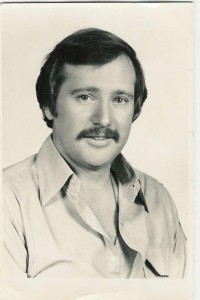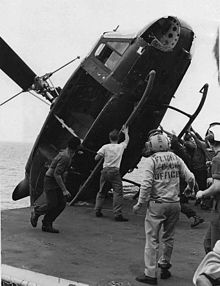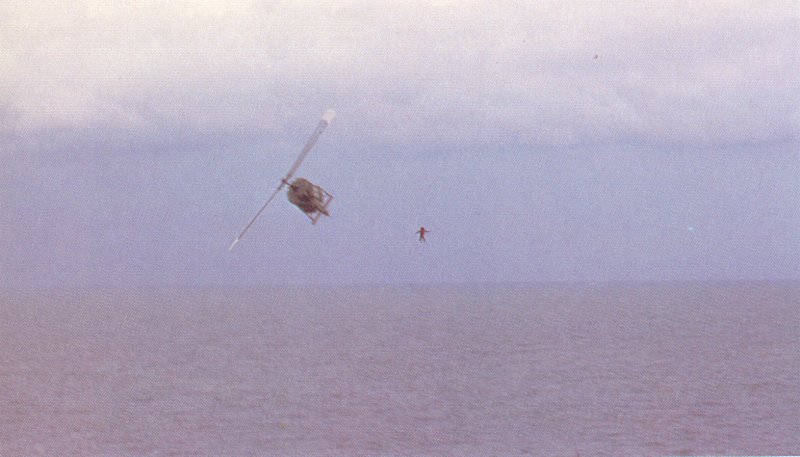[This is a follow-up to the story I posted last month on the 47th anniversary of the Fall of Saigon in 1975. )
After several dozen others and I were evacuated on April 29th, 1975 from the hulking Military Assistance Command-Vietnam building at Saigon’s Tan Son Nhut airbase I filed my final story from the U.S.S. Blue Ridge, the Amphibious Command & Control (LCC) ship of the U.S. Navy’s 7th Fleet.

The story eventually ran in the Chicago Tribune on May 4. I have attached a PDF copy of it below.
Our evacuation chopper, a Marine CH-53 Sea Stallion, landed us on the U.S.S. Denver several miles off the coast of Vietnam. For part of the late afternoon after our arrival, I watched Navy crewmen shove one Bell UH-1 Huey helicopter after another off of Denver’s deck. Even though the Denver was an amphibious transport dock with room for several CH-46 Sea Knight helicopters so many South Vietnamese Air Force Hueys were arriving that there was no room on the deck.

When South Vietnamese pilots were waved off from landing on the deck, they flew a few hundred yards away from the ship, allowed their helicopters to hover in the air, and then jumped into the ocean, the helicopter’s blades barely missing them as the choppers crashed into the sea.

That afternoon I and several other correspondents who had arrived during the evacuation were transferred by helicopter to the Blue Ridge. I spent the first night after evacuation on the Blue Ridge gazing at a scarlet sun as it sank below a darkening Vietnamese horizon. It was then that it all hit me. The United States had not only lost the longest war in its history (at that time), we had been driven out with our tails between our legs.
It was a reprehensible and dishonorable departure made even worse by the fact that we had left so many loyal Vietnamese behind who, up until the last few minutes, believed that the Americans they had worked for and supported would help them escape their Communist enemies.
As it turned out, several hundred thousand of those steadfast Vietnamese wound up languishing and even dying in Communist “re-education camps”–a North Vietnamese euphemism for what the Nazis called Konzentrationslager.
[As bad as that day in Vietnam was, it seems like a well-coordinated and perfectly staged event when contrasted with our disgraceful and botched withdrawal from Afghanistan in which hundreds of American citizens and loyal Afghanis were left behind and 13 American soldiers were killed.]
A flood of emotions washed over me: shame, sorrow, guilt, and finally anger at the way it all ended after so much sacrifice by so many. Some 58,000 Americans, of the 3.4 million who served in Vietnam, died there. Even more tragic were the 3.1 million Vietnamese, both civilian and military, who died between 1955 and 1975.
I recall U.S. Ambassador Graham Martin coming to an area of the Blue Ridge where a majority of journalists were ensconced. He was quickly surrounded by reporters demanding to know why the evacuation was not done earlier so more Vietnamese could have gotten out of the country. Why was the evacuation done in such a frantic and panic-stricken way?
Martin was not well. He had been suffering from pneumonia for several weeks, and he was weak and fatigued from the medication he had been taking. He was also a chain smoker and during conversations, was given to lingering coughing spells.

None of his answers satisfied the reporters who surrounded him that day on the Blue Ridge. Of course, all of us knew what Ambassador Martin thought. For weeks, he had insisted that the Americans would not run away, that South Vietnam would not fall into chaos and terror, that the U.S. would stand by its South Vietnamese allies as long as necessary.
Of course, as reporters watched the North Vietnamese Army march inexorably south toward Saigon with little or no resistance we knew that what Martin was saying publicly did not match the unvarnished truth that proliferated in the U.S. Embassy.
“This war is done,” one of my intelligence sources told me in early April. “We need to be thinking about how we are going to get out of here.”
Getting out of Saigon seemed to be the last thing on Graham Martin’s mind, however.
On April 28, after the first rocket attacks on Saigon by the Communists in several years, Ambassador Martin took the unprecedented step of going on Saigon television to promise that America was not leaving Vietnam in the lurch.
“I, the American Ambassador, am not going to run away in the middle of the night. Any of you can come to my home and see for yourselves that I have not packed my bags. I give you my word,” he told the Vietnamese people.
Whether the Vietnamese people believed Martin or not was irrelevant. Less than 48 hours later Martin was aboard the U.S.S. Blue Ridge with the rest of us trying to make sense of what had happened.
“The situation just got away from us,” he told me. “It is a sad day for America, for South Vietnam. I did the best I could.”
“I guess we can be relieved that it’s all over now,” I said.
“I can’t…not with the way it ended,” replied Martin, whose foster son died in combat in Vietnam in 1965.
Martin, a career diplomat who succeeded Ellsworth Bunker as the last U.S. Ambassador to South Vietnam in 1973, died in 1990.
That day aboard the U.S.S. Blue Ridge, Martin was a broken man. He had done what he thought best. In retrospect, which of course is always 20/20, he and the U.S. administration failed the South Vietnamese people.
Without a doubt, it could be argued that that failure began when the first U.S. Marines landed unopposed at Da Nang in 1965 and continued for the next eight years as successive administrations dithered and waged a war they never intended to win.
Sadly, it is a pattern that seems to have repeated itself since then in places like Iraq and Afghanistan where we expend precious treasure in blood and material only to depart before even a semblance of victory, hollow or otherwise.
As for me, I am thankful that I will never have to witness and report on such a pathetic, disgraceful, and ignominious exodus ever again.
Of course, as with millions of others, I witnessed America’s shameful and dishonorable escape from Afghanistan–a bungled and sickening event for which an apparently insensible Joe Biden deserves to be impeached.
The link below will take you to a pdf of the final story I filed about the Fall of Saigon.
The last days of Saigon, May 4, 1975


Thanks for sharing this Ron. Biden is a pure traitor in every sense of the word several times over. Every action, without exception, he takes is designed to benefit those who hate us at the expense of our Nation and citizens.
You are right, Joe. We are seeing it every day–from the open border to gas prices designed to force us away from internal combustion engines and gasoline, to runaway inflation and a broken supply chain designed to force greater dependency on government and undermine our capitalist system. We are seeing the communist/socialist takeover of our nation and as I said in a previous post, many Americans are like “a dog watching a plane crash.” They can’t comprehend what it means. It means the end of the country that you and I grew up in and loved. Sad.
A sad day indeed, Ron. I’m glad you pointed out an even sadder day under Biden. Thank you for being there and living through that hell and helping us understand how terrible it was.
Thanks, John. Some stories have stayed with me my entire life. This was one.